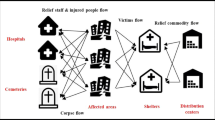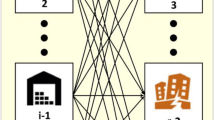Abstract
People are always threatened by natural disasters which usually cause significant losses. Therefore, planning for confronting such situations is a vast dilemma. In this paper, a general model is proposed to address the uncertain demand of disaster-stricken areas. Demand from injured people relates to the vulnerability of regions that depends on the quality of buildings and severity of damage. In the studied problem, the commodities collected from relief centers, donations and storage warehouses are distributed to the shelters. It aims at minimizing the total cost, and unfulfilled demand and maximizing the coverage and accessibility of relief centers. The LP-metric approach is utilized to solve the multi-objective model, and a scenario-based optimization is used to incorporate the uncertainty in the proposed model. Moreover, an LP–GA method is proposed for optimizing large-scale instances. Several problems in different scales are solved to show its flexibility and time-efficiency. Finally, a case study of an earthquake disaster in Amol city in Iran is presented. The obtained results suggest better service in the distressed urban areas.











Similar content being viewed by others
References
Toregas C et al (1971) The location of emergency service facilities. Oper Res 19(6):1363–1373
Özdamar L, Ekinci E, Küçükyazici B (2004) Emergency logistics planning in natural disasters. Ann Oper Res 129(1–4):217–245
Alçada-Almeida L et al (2009) A multi objective approach to locate emergency shelters and identify evacuation routes in urban areas. Geogr Anal 41(1):9–29
Horner MW, Widener MJ (2011) The effects of transportation network failure on people’s accessibility to hurricane disaster relief goods: a modeling approach and application to a Florida case study. Nat Hazards 59(3):1619–1634
Gutjahr WJ, Dzubur N (2016) Bi-objective bi-level optimization of distribution center locations considering user equilibria. Transp Res Part E Logist Transp Rev 31(85):1–22
Rottkemper B et al (2011) Inventory relocation for overlapping disaster settings in humanitarian operations. OR Spectr 33(3):721–749
Bozorgi-Amiri A, Jabalameli M, Al-e-Hashem SM (2013) A multi-objective robust stochastic programming model for disaster relief logistics under uncertainty. OR Spectr 35(4):905–933
Rezaei-Malek M, Tavakkoli-Moghaddam R (2014) Robust humanitarian relief logistics network planning. Uncertain Supply Chain Manag 2(2):73–96
Hu S-L, Han C-F, Meng L-P (2015) A scenario planning approach for propositioning rescue centers for urban waterlog disasters. Comput Ind Eng 87:425–435
Zokaee S, Bozorgi-Amiri A, Sadjadi SJ (2016) A robust optimization model for humanitarian relief chain design under uncertainty. Appl Math Model. https://doi.org/10.1016/j.apm.2016.04.005
Lin Y-H et al (2011) A logistics model for emergency supply of critical items in the aftermath of a disaster. Socioecon Plann Sci 45(4):132–145
Bozorgi-Amiri A et al (2012) A modified particle swarm optimization for disaster relief logistics under uncertain environment. Int J Adv Manuf Technol 60(4–1):357–371
Zheng Y-J, Ling H-F (2013) Emergency transportation planning in disaster relief supply chain management: a cooperative fuzzy optimization approach. Soft Comput 17(7):1301–1314
Saeidian B, Mesgari MS, Ghodousi M (2016) Evaluation and comparison of Genetic Algorithm and Bees Algorithm for location–allocation of earthquake relief centers. Int J Disaster Risk Reduct 15:94–107
Mulvey JM, Vanderbei RJ, Zenios SA (1995) Robust optimization of large-scale systems. Oper Res Int J 43(2):264–281
Yu CS, Li HL (2000) A robust optimization model for stochastic logistic problems. Int J Prod Econ 64:385–397
Dep K (2001) Multi-objective optimization using evolutionary algorithms. Wiley, Chichester
Bootaki B, Mahdavi I, Paydar MM (2014) A hybrid GA-AUGMECON method to solve a cubic cell formation problem considering different worker skills. Comput Ind Eng 75:31–40
Altiparmak F, Gen M, Lin L, Karaoglan I (2009) A steady-state genetic algorithm for multi-product supply chain network design. Comput Ind Eng 56:521–537
Gen M, Cheng RW (1997) Genetic algorithms and engineering design. Wiley, New York
Sadeghieh A, Dehghanbaghi M, Dabbaghi A, Barak S (2012) A genetic algorithm based grey goal programming (G3) approach for parts supplier evaluation and selection. Int J Prod Res 50(16):4612–4630
Abdulhamid SIM, Abd Latiff MS, Madni SHH, Abdullahi M (2018) Fault tolerance aware scheduling technique for cloud computing environment using dynamic clustering algorithm. Neural Comput Appl 29(1):279–293
Moradgholi M, Paydar MM, Mahdavi I, Jouzdani J (2016) A genetic algorithm for a bi-objective mathematical model for dynamic virtual cell formation problem. J Ind Eng Int 12:1–17
Geological and mining engineering and sciences. www.geo.mtu.edu. Accessed 20 Nov 2016
Guha-Sapir D, Below R, Hoyois P EM-DAT: The CRED/OFDA International Disaster Database. University Catholique de Louvain, Brussels, Belgium. www.emdat.be. Accessed 20 Nov 2016
Author information
Authors and Affiliations
Corresponding author
Ethics declarations
Conflict of interest
Hasan Molladavoodi, Mohammad Mahdi Paydar, Abdul Sattar Safaei certify that they have no affiliations with or involvement in any organization or entity with any financial interest (such as honoraria; educational grants; participation in speakers’ bureaus; membership, employment, consultancies, stock ownership, or other equity interest; and expert testimony or patent licensing arrangements) or non-financial interest (such as personal or professional relationships, affiliations, knowledge or beliefs) in the subject matter or materials discussed in this manuscript.
Rights and permissions
About this article
Cite this article
Molladavoodi, H., Paydar, M.M. & Safaei, A.S. A disaster relief operations management model: a hybrid LP–GA approach. Neural Comput & Applic 32, 1173–1194 (2020). https://doi.org/10.1007/s00521-018-3762-0
Received:
Accepted:
Published:
Issue Date:
DOI: https://doi.org/10.1007/s00521-018-3762-0




